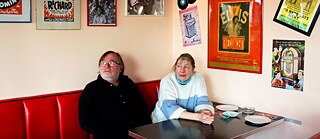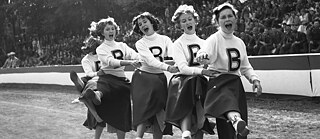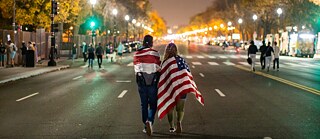Food and Community
The Diner
What happens when you uproot an American institution like the diner and place it somewhere entirely new — like Germany? Florenz Gilly and Leon Ginzel journey into the world of diners, visiting hometown restaurants in the U.S. and Germany to find out.
Listen to this episode: Apple Music | Spotify | Download
The Berlin-based duo Florenz Gilly and Leon Ginzel produced this story. Florenz is a freelance reporter and the producer of the podcast This is Ithaca. During a year abroad at Cornell University in Ithaca, New York, he covered local news for the town’s radio station WVBR. Leon works as a freelance reporter for various German radio stations and is the co-host of the podcast Doppelspitze. In 2019, Leon worked at KUOW in Seattle as a fellow of the RIAS Berlin Kommission. For this episode, Florenz and Leon speak with diner owners, patrons, and employees from the Courtesy Diner in St. Louis, Missouri; Lincoln Street Diner in Ithaca, New York; the Cruise-In Diner in Berlin, Germany; and Big’s Diner in Nauen, Germany. “The Diner” is also available in German. The music for “The Diner” was licensed through Blue Dot Sessions. The sound effects are from joedeshon, OGsoundFX, lonemonk, and n2p5, all licensed under CC BY 3.0 licenses via Freesound. Leon Ginzel took the featured photo of Andreas Weinfort and Birgit Majewski at Big’s Diner.
Transcript
[MUSIC]
Christopher O’Brien: I think most people perceive an American diner as greasy spoon, sort of relaxed, casual. You’re not gonna find fine dining sauces, you are not gonna find parsley sprinkled on your plates.
Joly Wait: Locals, construction workers, city workers. That type of style people come in. So a lot of, you know, goofing around people giving you quote unquote “shit.”
[AMBIENT SOUNDS]
Richard Gutman: How can you not notice a building that is stainless steel, rimmed with neon, gigantic signs flashing, saying: “Eat here. Eat heavy. Open 24 hours.” How did these things stay under the radar? For a century?
[AMBIENT SOUNDS]
Male Customer: Two eggs, two strips of bacon, one sausage patty, two pancakes, hashbrowns for 7.95.
[AMBIENT SOUNDS]
Christina Teal: If you want healthy, they’re going to open a Starbucks across the street. [LAUGHING]
[MUSIC]
Leon Ginzel: According to the Merriam-Webster dictionary, a diner is, quote unquote, “a small, informal, and inexpensive restaurant that looks like a railroad car.” So far so good. But what is it that makes diners so popular? How did they change over time? And what happens if you try to plant something, that is so deeply rooted in American culture, somewhere new, like in Germany?
Florenz Gilly: Today we take you on a journey through time and space, to diners, old and new, in St. Louis and Upstate New York, in Berlin, Germany, at highway junctions along the Autobahn, and in a town called Nauen, just 40 kilometers west of the German capital.
Leon Ginzel: We will meet people who are crazy about diners and who celebrate this peculiar piece of America’s culture, on this and on the other side of the Atlantic. And, we will tell you why Edward Hopper’s Nighthawks, probably the most famous artwork illustrating a diner ever, is actually an illusion.
Florenz Gilly: Totally!
[MUSIC]
Leon Ginzel: My name is Leon Ginzel.
Florenz Gilly: And I’m Florenz Gilly.
Leon Ginzel: This is THE BIG PONDER: A podcast by the Goethe-Institut. This episode: “Why Edward Hopper Was Wrong.” No, just joking. This episode: “Exploring Diner Culture Here and Abroad.”
[MUSIC]
[KITCHEN AMBIANCE]
Andreas Falkenhain: [IN GERMAN] Bestseller sind natürlich halt die Burger, gar keine Frage, dit bleibt so dabei. Da würd ick halt sagen wollen, ist der Klassiker der Bacon-Cheese. Bleibt einfach so, da gibt es nüscht. Dis krosse mit dem Bacon und mit Zwiebel, mit BBQ-Soße mit drauf, Rindfleisch, Käse überbacken. Käse kann immer viel Käse sein, gar keine Frage, wa, dit nimmt ja jeder. Am besten immer doppelt Käse, damit dit auch immer schön schmilzt und denn renn dit.
Florenz Gilly: Ground beef. Crispy bacon. Onions. Barbecue sauce. And cheese. Lots and lots of cheese. To Andreas Falkenhain, owner of Berlin’s oldest diner, this is what belongs in a classic Bacon-Cheese-Burger, by far the best-selling item on his menu. When we meet Andreas, he wears a lumberjack shirt, plaid in black and blue. For more than 15 years, the sturdy, short haired man has run the Cruise-In Diner in Spandau.
Leon Ginzel: Located on a parking lot next to department stores, it looks like the small copy of Mel’s Diner from the 1973 George Lucas movie American Graffiti. A round glass pavilion, with a roof like a big flat umbrella, shiny red lights at night. Before, the building was used as a sales display for ceramics like sinks or kitchen tiles.
[COOKING NOISES]
Leon Ginzel: Today the spot still revolves around the kitchen. But: not as slick or clean as a new tile. The Cruise-In Diner has added a different, say, greasier touch.
Andreas Falkenhain: [IN GERMAN] ‘John Wayne Burger’ is’ immer so dann dit overtop nochmal. Dit sind zwei Scheiben Fleisch, 180 Gramm, Chili con Carne mit drauf. Da haste so gute 400, 500 Gramm Fleisch haste schon mal nur da. Dann ist dit so’n Trümmer, der so 20 Zentimeter hoch ist. Da haste reichlich zu essen. Dit reicht für einen Bauarbeiter oder für fünf kleine Mädels ...
Florenz Gilly: Hallelujah. Two burger patties made from one pound of meat, topped with a good ladle of chili, stacked up to a burger about eight inches high. The Cruise-In Diner’s ‘John Wayne Burger’ is enough to feed, to quote Andreas, “one construction worker or five small girls.”
[KITCHEN SOUND]
Florenz Gilly: What sounds like a crazy super-size meal is not uncommon for diners. In fact, every diner has, in one way or another, something like a John Wayne Burger on their menu.
Leon Ginzel: Diner food is all about comfort — soul food, in a way. It might not be the healthiest on earth. But it’s fresh. And special. Perfect example: the signature dish of the 24/7 Courtesy Diner in St. Louis, Missouri. I just say one word: the ‘Slinger.’
Christina Teal: It’s about a half pound of hamburger patties, two eggs however you want them, it comes with a side of toast. You can also get it topped with cheese and onions. Some people put a tamale or burrito on it. That’s a Slinger! It’s a St. Louis thing.
[DINER AMBIANCE]
Leon Ginzel: In her ten years of working as a waitress, Christina Teal has definitely served a lot of Slingers. They are made in an open kitchen right behind the long counter at the Courtesy Diner where you can sit and watch the eggs sizzling. Just as popular is the so called ‘Hangover:’ fried chicken, hash browns, two eggs, and gravy. And of course, everything you need for a hearty breakfast, like french toast or eggs any way you want. Scrambled. Fried. Or as an omelet.
Florenz Gilly: Apparently, omelets are a real diner thing ...
Joly Wait: We do a buffalo chicken omelet. We do a cheeseburger omelet. We do a spinach and feta omelet. We do a chili and cheddar omelet. We do a Mac’n’Cheese’n’bacon omelet.
Florenz Gilly: This is Joly Wait. She works as a waitress at the Lincoln Street Diner in Ithaca, New York. My favorite restaurant when I spent a year abroad as a college student. Their signature dish was called the ‘Siffy.’ It’s an omelet with ham, tomato, onions, bacon, home fries, and cheese folded right inside of it. And on top, the whole thing gets drowned in sausage gravy. Joly called it ‘the heart attack on plate.’
Leon Ginzel: Heart attack on a plate ... Oh wow, that sounds dangerous. But there are also options for more dietary conscious people.
[MUSIC]
Leon Ginzel: Fish and salads have long been part of diner menu. And: As we will hear later, diner culture is changing. You will find more and more vegetarian and vegan options. In the U.S. as well as in Germany.
[MUSIC]
Florenz Gilly: Here comes an ironic part. When Leon and I were talking to German diner owners about their menu, we frequently encountered this weird notion of purity. A real diner serves nothing but burgers — and maybe some eggs and milkshake. That’s it. That’s what they said. In the U.S., however, you will find a wide variety of stuff on the menu, from quesadillas to lobster bisque to Caesar’s salad. The sky is really the limit here.
Richard Gutman: There are diners that have menus that are so huge that when you have four people sitting at a table, you can't even open them up. Because there are so many options on them.
Florenz Gilly: This is Richard Gutman — America’s leading expert on all things related to diners. Since the 1970s, Richard has thoroughly studied this part of American culture. He wrote several books about the topic, has collected diner paraphernalia — so everything from old diner menus to postcards to toothpicks —, and he definitely had a taste at a decent amount of diners across the States.
Leon Ginzel: To be honest, Florenz, I expected him to be — let’s say — bigger. But: he has a quite normal stature, hasn’t he? Glasses, grey hair. As an architecture student he was fascinated by the design of diners, that’s when he started to become a ‘diner devotee.’
Florenz Gilly: From Richard, we also learned a lot about the history of diners. Leon will give us a little briefing here.
[VINTAGE EFFECTS / VINYL / HORSES]
Leon Ginzel: Diners originated from horse-drawn lunch wagons which came out at night on the city streets, serving cheap hot dogs or Frankfurters to the working crowd.
[SXF CARS AND HORNS]
Leon Ginzel: When more and more cars filled the streets, the wagons had to move. To set places on the roadside. By the 1920s, manufacturers were producing complete units which were roomier and cleaner. People began calling them ‘diners,’ evoking the elegance of a railroad dining car. Again the diner devotee Richard Gutman:
Richard Gutman: Most of the authentic, classic diners — the pre-fabs — the ones that looked like railroad cars, those were built and originated in the eastern part of the United States. But they were shipped. And you’ll find some in Utah, and you’ll find some in St. Louis, in Chicago and California.
Leon Ginzel: Without cars, diners would have never become so big. In the 1950s, new highways were built, and thanks to mass production more and more people could afford their own vehicle. Traveling in your car and eating at diners was a perfect match.
Richard Gutman: If you saw a diner, on the highway, you would know, okay, this is a place where I can go and get some good hot coffee, maybe some homemade pie, it’s gonna not set me back much, and I know what to expect there.
Leon Ginzel: The ’50s were a time when fast food chains like McDonald’s popped up all over the place. A huge competition for diners because those franchises offered hamburgers for an unbelievable 15 cents — served in 20 seconds. But: diners struck back. With personal customer service and a unique atmosphere. A strong contrast to the ‘same-old-same-old’ of most fast food chains.
Richard Gutman: And then all of a sudden, in the 1970s and ’80s, people said, hey, wait a minute, these things are amazing. Let’s pay a little more attention to them. Let’s save them, let’s rescue them. Let’s restore them. Let’s put them in commercials, let’s put them in movies ... and it became this kind of thing where it took on a life of its own, really.
Leon Ginzel: And here we are ...
[SFX VINYL AND PROJECTOR FADE OUT]
Leon Ginzel: ... talking about diners in the year 2021 ...
[MUSIC]
Joly Wait: Locals, construction workers, city workers. That type of style people come in.
Florenz Gilly: One reason why diners are still so successful is their key role in society. Historically, diners have been known to attract all sorts of people, no matter where they came from or how much money they had.
Leon Ginzel: Because of their place in society, diners play an important role also in politics. Nearly every presidential candidate stops at a diner during their campaign. To get close with the guests and thereby possible voters.
Florenz Gilly: But is it really true that diners are representative for the American people? They sure are, says diner historian Richard Gutman. According to him, the diner managed to preserve its democratic spirit.
Richard Gutman: There are policemen, there are working men who are in working clothes that have mud and dirt and other kind of things on them. Literally, you’ll find college professors with the blue collar. And the fact is that that’s been happening for the entire history of diners. So, true that.
Florenz Gilly: The diner as a melting pot of American society? An open place of social diversity, where you will find people of all different classes and origins? You know, I’m not so sure about that. From what I saw traveling the U.S.’s East Coast, the average diner is a pretty white space. But I guess that also depends on where you go.
Leon Ginzel: However, in Germany, too, diners are very casual restaurants. Cruise-In Diner owner Andreas Falkenhain says he treats all his guests equally. As if they were on a school trip.
Andreas Falkenhain: [IN GERMAN] Für mich is’ et so: Alle, die hier reinkommen, ob Stammkunde oder normaler Kunde, werden behandelt als wenn de hier auf Klassenfahrt bist. Der wird geduzt. Soll immer lieb, nett und freundlich sein, ja keene Frage. Und ’n Diners, hier werden wir nie ’ne weiße Tischdecke haben, hier werden wir auch nie ’nen Kellner erwarten können, der ’ne weiße Serviette um den Arm hat. Ne Weinkarte gibt es auch nicht. Aber der Service muss sauber und ehrlich sein. Und dann kommen auch so die Gäste rüber.
Florenz Gilly: Fact is also that diners, in the States and in Germany, have a very special clientele.
Leon Ginzel: I think now it’s time to introduce Birgit.
Birgit Majewski: [IN GERMAN] Mein Name ist Birgit Majewski und mit meinem Lebenspartner zusammen und meinem Sohn betreiben wir das Big’s Diner in Nauen.
Leon Ginzel: Birgit Majewski. Imagine a 60 year old woman, dark-blonde hair, tied into a braid. As we talked to her, sitting in one of the corner booths, she wore a blue and white striped wool sweater. Together with her husband and son, Birgit runs Big’s Diner in Nauen. Situated in an industrial area with car dealers all around, her diner is a popular destination for diner enthusiasts from all around. For 15 years. And Birgit has a close relationship to all her guests.
Birgit Majewski: [IN GERMAN] Ich liebe und leide mit meinen Gästen. Also, ich kenne Geschichten, Familiengeschichten, Betriebsgeschichten, sonst was, wie auch immer. Aber wir sind teilweise Teil der Familien, beziehungsweise die Familien sind Teil von uns. Über 15 Jahre ist das schon gewaltig, was da zusammengewachsen ist.
Florenz Gilly: Listening to Birgit talk, we got the impression that at Big’s Diner, she doesn’t only serve as a waitress. She also serves as a therapist and a friend to her guests. She knows their stories. She even considers herself as part of their families and vice versa. This familiarity, if you want, is clearly a distinguishing feature of some diners here and in the US.
[MUSIC]
Florenz Gilly: One thing that sets a diner apart from, at least, fast food restaurants is that they get a lot of regulars. If you go there frequently, the staff will remember your face. So does Christopher O'Brien, proprietor of Ithaca’s Lincoln Street Diner.
Christopher O’Brien: You know you see people come in and Jolly will turn around and get their drinks knowing full well what it is. And they don’t have to keep ordering. They don’t have to keep doing that kind of stuff. They are comfortable. I think the comfort level is huge here.
Jolly Wait: Oh absolutely. The ‘Cheers of Ithaca’ is what people call us, where everybody knows your name.
Leon Ginzel: Similar picture in St. Louis. Staff has been working together for decades. And the customers appreciate their reliability. 67-year-old Phil Catanzaro, for example, has been a regular at the Courtesy Diner for ehm ... well, listen yourself:
Phil Catanzaro: 18 years. Every day for 18 years. I love the food, also I love the waitresses, they’re all friends of mine, so I’ve been in here for years. It’s like family, like family for me.
Leon Ginzel: So, diners in the U.S. are a contemporary thing. Very much alive. Down-to-earth. Casual. No thrills. Going there is no sensation. You don’t make a lot of fuss about it.
[MUSIC AND DINER AMBIANCE]
Florenz Gilly: The counter is the center of each diner in the US. There you can have small talk with both guests and staff, drink your coffee, not feel alone even if you came in there all by yourself.
Birgit Majewski: [IN GERMAN] In den USA ist das gang und gäbe. Man kommt rein und setzt sich erstmal an die Bar ...
Florenz Gilly: So what Birgit is saying is that, in America, you will likely be asked by the waitress to sit down at the counter, where you can stay to eat or wait until you get seated elsewhere — that is not too common in Birgit’s restaurant: When guests come in, they will rather go for one of the booths. And if there is already a couple in the dining room, they will go sit down as far away as possible:
Birgit Majewski: [IN GERMAN] ... is ’n Deutschland ganz anders. Wenn wir jetzt in Deutschland so ’n leeren Laden haben, dann setzt sich ein Pärchen hier hin und ein Pärchen da hinten hin. Und das ist Deutschland. Nicht alles lässt sich projizieren ...
[MUSIC]
Leon Ginzel: So, as we learned: Not everything translates seamlessly. There are cultural differences between Germany and the U.S. Different mentalities, which lead to different ways people use a diner.
Florenz Gilly: As we have seen, going to a diner in the U.S. is the most common thing to do. In Germany, if you go to a diner, you are either an expat, or someone who is really into the US. Bikers, car lovers, students who spent a year abroad, tourists. Going to the diner is more like a spectacle than an everyday ritual.
[SFX HARLEY AND CHEVY]
Florenz Gilly: You take your Harley or your 1960s Chevy for a night out. And perhaps you might even dress up.
Leon Ginzel: And the extravagant interior of the diner is part of the experience. Take Andreas’ Cruise-In Diner, for example.
[AMBIANCE PARKING LOT AND WALKING IN]
Leon Ginzel: Entering the brightly lit glass pavilion – again, a small copy of George Lucas’ Mels Diner — we immediately felt as if we were walking into a film set of an old movie. Loud colors, red leather booths, old music playing in the background. There are football jerseys hanging from the ceiling. In one corner, there is an old Coca Cola refrigerator, which belonged to the American base down in Zehlendorf.
Florenz Gilly: Correspondingly, Andreas compared a visit to his burger joint as hopping onto a time machine.
Andreas Falkenhain: [IN GERMAN] Na, wie zeitversetzt. Wie ’ne Zeitmaschine. Ick würde sagen einfach: 60er-Jahre. Is allet so stehengeblieben. Bleibt auch allet so. Der Laden lebt ja davon. Dit müssen überall Pastellfarben drin sein. Dit muss aussehen wie ’ne Bonbonfabrik. Und dann passt dit auch, ja.
Florenz Gilly: Like a candy shop, stuck in the sixties. With pastel colors everywhere. And a shiny decor.
[AMBIANCE PARKING LOT]
Leon Ginzel: Same in the city of Nauen, a thirty minute car ride west of Spandau. A whitewashed, flat long building, with a ballroom attached to it and a pin-up girl above the entrance.
[AMBIANCE INSIDE]
Leon Ginzel: Inside you’ve got the typical red leather furniture. Tiled floor in checkerboard pattern. U.S. license plates hanging on the wall — anywhere from Utah to Delaware. An old coin-operated phone. Posters from movie stars like Marylin Monroe, or famous musicians like Elvis.
Florenz Gilly: Birgit and her husband have built the diner all by themselves. They put all their money, all their energy and all their passion into it.
Birgit Majewski: [IN GERMAN] Dis is Herzblut. Dieser ganze Laden ist Herzblut. Ganz viel.
[MUSIC]
Florenz Gilly: As we learned through Leon Ginzel’s history lesson, the success of the American diner has a lot to do with the construction of interstate highways in the 1950s.
Leon Ginzel: Exactly. And, oddly enough, in Germany, diners are built along highways, too.
Florenz Gilly: Imagine you are doing 125 miles per hour on the infamous German Autobahn, trees and buildings passing by, and all of a sudden you realize that you’re getting a little hungry. Next thing you do, you drive off the highway, at a service area with the promising name: ‘Am Fichteplan.’ And what do you find there? One of those typical neon-signs no-thrills American diners.
[AUTOBAHN AMBIANCE]
Florenz Gilly: Those diners, however, are different from the ones we visited in Nauen, Ithaca, and Spandau in that they belong to a bigger chain. Like Burger King or Wendy’s but not as big. One is called Cindy’s Diner, another one: Sam Kullman’s Diner, which looks exactly like the old chrome-plated carriages, with branches in Ludwigsburg, Regensburg, Würzburg ...
[TRUMPET-FANFARE]
Leon Ginzel [VOICE EFFECT]: Germany — land of castles ...
Florenz Gilly: ... also in Kaiserslautern and in Linthe, just south of Berlin.
[BLINKING AND CAR AMBIANCE]
Florenz Gilly: That’s where we went on a sunny yet cool afternoon.
Leon Ginzel: We caught people eating burgers while sitting in their cars or campers and asked them why they came there.
[PARKING LOT AMBIANCE]
Leon Ginzel: What it is that made them chose Kullman’s over, say, the big, much cheaper eating alternative right across on the other side of the parking lot?
Florenz Gilly: For this couple from Zwickau, for example, it is the old ’50s and ’60s flair that invited them to an extended stay.
Female customer: [IN GERMAN] Na dieses Flair von diesem Alten, also das fanden wir eigentlich immer toll.
Male customer: [IN GERMAN] Fuffziger-, Sechzigerjahre. Passt halt eben. Und nicht wie McDonald’s. Alles neu. Alles schick, alles clean. So is’ herrlich. Sitzt man auch mal ein Stückchen länger. Bestellt halt eben mal noch was.
Florenz Gilly: Our next interviewee, Hans, was also drawn by the style of Kullman’s, which, fun fact, was actually shipped from Newark, New Jersey. Also, Hans appreciated that the food is made from scratch, rather than being pre-packaged.
Leon Ginzel: Well, at least that’s what we want to believe.
Male customer: [IN GERMAN] Es ist halt einfach frisch, man merkt das auch. Also auch die Qualität und der Geschmack ist ganz anders. Also es schmeckt wie wenn man ’s selber grillt.
Florenz Gilly: The fact that Kullman’s Diner is located right by the highway doesn’t bother Hans at all.
Male Customer: [IN GERMAN] Gar net. Also mich stört das gar net ...
Florenz Gilly: Scattered along highways and interstate routes, tugged away in side-streets or industrial areas, diners are transition spaces. You go there, you sit down, you eat ...
[MUSIC]
Florenz Gilly: ... and then you leave.
Leon Ginzel: So, the concept of the diners has been imported to Germany and obviously there is a demand for them, otherwise restaurants like Sam Kullmann’s or Cruise-In Diner wouldn’t exist. Yet, they still remain exotic to Germans’ culinary landscape. Something that sticks out of the wide range of the international cuisine you would normally get. As Birgit Majewski reports, customers that are new to her Big’s Diner in Nauen sometimes have false expectations.
Birgit Majewski: [IN GERMAN] Teilweise haben sie verkehrte Vorstellungen, weil viele uns dann sagen: „Ja und Rollschuhe müsst ihr euch noch umschnallen!“ Und und und ...
Florenz Gilly: Some people, who come in, ask Birgit why the staff is not wearing roller blades, like those car hops who, in the happy old days, served food to people sitting in their parked vehicles.
Birgit Majewski: [IN GERMAN] ... das sind über Filme projizierte Wunschträume.
Leon Ginzel: Dreams, derived from movies. Birgit touches on a very important aspect in the history of the German diner: that our perception or idea of diners is highly influenced by movies, music, and iconic images. Movies like American Graffiti or the 1982 coming-of-age story Diner, shot in Baltimore — or Quentin Tarantino’s Pulp Fiction. No wonder that reality is not always what we expect it to be.
Florenz Gilly: We already talked about diners as democratic places. This notion that diners are open to everyone.
[MUSIC]
Florenz Gilly: Another myth would be that Edward Hopper’s Nighthawks, painted right after the Japanese attacked Pearl Harbor, is an adequate representation of the diner as such. Hardly any documentation or article on the diner goes without reference to Hopper’s 1942 painting. But ...
Richard Gutman: In fact it’s not an even a classic diner because it’s got gigantic windows which they didn’t have in 1940. The interior is totally plain — whereas inside a diner there is a riot of fabulous patterns of stainless steel, ceramic tile, there is tons of food on display.
Florenz Gilly: Instead, the two loners Hopper placed sitting at the counter, only drink coffee out of two white coffee mugs. And as far as I can see, there are no ketchup bottles standing around — which, in a real diner, I have rarely seen empty.
Leon Ginzel: Truth is though that, in contrast to most German diners, many American diners are open 24/7, like the Courtesy Diner in St. Louis.
Christina Teal: Breakfast, lunch, dinner. We have a lot of third shift, after bar crowds, drunk crowds. 1am, 3am, 5am. [LAUGHING]
Florenz Gilly: I actually heard that some diners don’t even have door locks because they’ve never closed since they first opened up.
Leon Ginzel: Yes, and this makes the diner a perfect refuge not only for the workforce on the way to and from their shifts, but also for night-owls.
Florenz Gilly: Like policemen, for example, government employees, doctors on call, night guards, architecture students who need to finish up a project and realize in the middle of the night that they might need something to eat. Where do you go when everything else is closed? To the diner!
Leon Ginzel: To the diner.
[MUSIC]
Florenz Gilly: One can see that in Rhode Island, where one of the country’s oldest diners is located: the Haven Brothers Diner. Every day at 4:30pm, the old diner car gets wheeled to the same spot in front of Providence City Hall — where it supplies lonely souls with coffee and a midnight snack.
❡
Florenz Gilly: So, Leon: Covering this story, what did you learn about diners? What is your takeaway?
Leon Ginzel: What struck me the most, is the passion of all those people we met. They really love what they’re doing. The way they design their diners, what food they serve, how they are related with their guests. I was also surprised how creative some signature dishes are. Like the ‘Slinger’ or the omelet list in Ithaca. I am a foodie so I love places in which you get something homemade and special. And what I really like is the vintage atmosphere. It’s a feel-good anchor in this restless age we live in. And you, Florenz?
Florenz Gilly: I think I was amused by, you know, the little mishaps or glitches when people translate American diner culture into a German setting. Whether it is their strict interpretation of the diner menu, or the fact that in German diners hardly anyone sits at the bar. The sumptuousness of both the food and the interior. And although Big’s Diner and the Cruise-In Diner are different to the ones we saw in the US — for instance, they seem to be stuck in the sixties — I would still consider them to be partaking in a global diner culture. For, as we learned from Richard, there is no such thing as this one and only ‘real American diner.’ It’s not limited to a single, exclusive concept:
Richard Gutman: The great point about the diner, and these paintings and these movies, and all of it is that, you can just take this and go off on a tangent. And it can mean a different thing to different people. And you can have your own little fantasy about it, you can discuss it ad nauseam with people in podcasts. It never ends.
Florenz Gilly: That’s also what we experienced. Whomever we talked to, everyone had their own ideas, their ‘own little fantasies’ about diners.
Leon Ginzel: What they all have in common though, is that a diner is a place with a soul, unique and irreplaceable.
[MUSIC]
Florenz Gilly: And where is the diner going from here?
Leon Ginzel: In the U.S., there is a trend to have healthier, fancier food on the menu like bowls with seaweed and brown rice. To make it more ‘instagramable.’
Florenz Gilly: Ha!
Leon Ginzel: The New York Times called those places ‘hipsterfied diners.’ Same look and vibe as the original, but the food has been upgraded to meet the current tastes.
Florenz Gilly: Richard Gutman predicts a good future for diners as well. He believes they will retain their distinctiveness as buildings that resemble no others in the American landscape. Inconspicuous yet always good for a hearty meal.
Leon Ginzel: From Berlin for THE BIG POUNDER, no, THE BIG PONDER, this was Leon Ginzel!
Florenz Gilly: And Florenz Gilly — we hope you had fun. Please feel free to get in touch. And if you are ever in Ithaca, St. Louis, Spandau or Nauen — please make sure to check out their local diners. Perhaps, you will find one of us sitting at the counter, working on a chili cheese burger.
Leon Ginzel: I’ll go for a ‘Slinger.’
Florenz Gilly: [IN GERMAN] Na dann — guten Appetit!
Leon Ginzel: See you later.
Florenz Gilly: Bye now.







